The Ferniehurst and Baildon Green Walk
This is one of the Heritage Walks created by Baildon History Society and commissioned by Baildon Parish Council.
The Heritage Walks page has details of how you can get a copy of this walk.
The Ferniehurst and Baildon Green Walk
Distance approximately 3 miles (5 km)
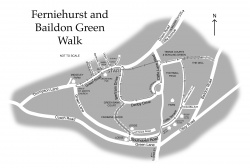
This walk visits the sites of two Victorian mansions and reveals some of their history, and explores the tightly-knit late-mediaeval hamlet of Baildon Green.
From The Cricketers to The Knoll
The walk starts at the Cricketers public house which stands on Green Road. Walk uphill a short way from the pub (up Green Road) past the notice board which provides information about Baildon Green and the surrounding area, which we shall look at again later. Turn right along Bertram Drive, which was named after Bertram Roberts who was one of the sons of Sir James Roberts who lived at the Knoll here in Baildon (and later at Milner Field, Gilstead – see The Coach Road to Shipley Glen Walk in this series). This road runs across the common land of Baildon Green, which gives it such a pleasant open aspect. Most of the houses you come to on the far side of the green are fairly modern, but here and there are older stone houses.
Continue along this road, passing one such on your right, a small stone house behind substantial hedges, and a newer block of flats called Green Bank Court. Just past the flats look for a paved way running across the grass to your right, among the trees. Follow this path until it joins a track and turn right down the track; this was the carriage drive for the Knoll which stood where the flats (on your left) have been built.
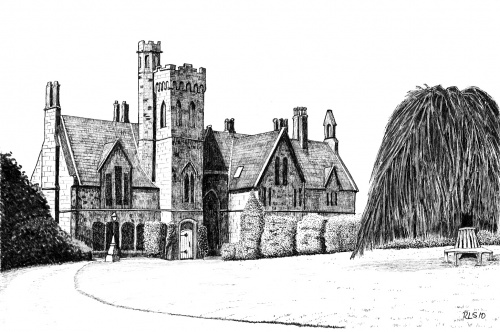

The Knoll was a large gothic-looking house which was built in the late 1850s/early 1860s by Charles Stead who was the first non-Salt director at Salts Mill. The land had originally belonged to the Ferrand Family, and it was sold to Titus Salt who then sold it to Charles Stead. There are photographs of the house but no building plans have survived. The house had beautiful grounds, the extent of which can be glimpsed from the 1893 Ordnance Survey map. Charles went bankrupt in the 1890s and moved away to the Morecambe area. The house was sold to the aforementioned Sir James Roberts who (along with a consortium of business men) had taken over the running of Salts Mill, and when Sir James moved to Milner Field his son Bertram and his family then lived here at the Knoll. Members of the family continued to live in the house until after World War I, but following Bertram’s death the house had various owners and there was even a suggestion that it should become a museum for Baildon. Eventually both the house and the estate were sold to Baildon UDC: the house was pulled down in the 1960s and the present flats put on the site.
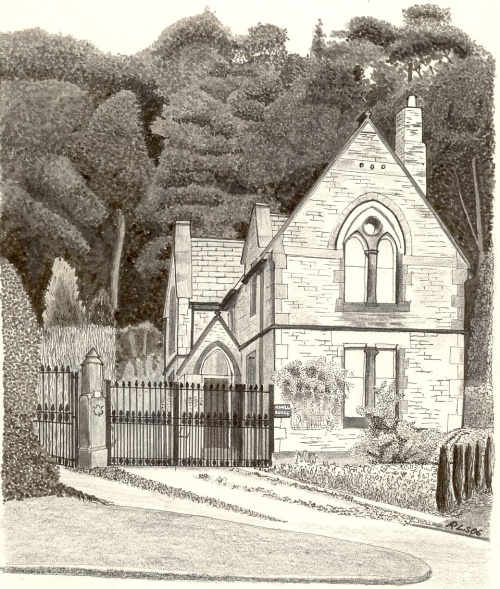
As you walk down the track you can sense something of the mansion’s former grandeur from the remnants of the Knoll gardens around you, and also small flights of steps which can be seen here and there. The wood on the right is known as Fairbank Wood after the family who used to live in a farmhouse on the edge of Baildon Green, on the site where now stands Bank View House. In 1948 the area around the drive was laid out as a recreation ground for Baildon; there were even rules and regulations for its use. There also used to be a small lodge halfway down the drive but this has been demolished. At the bottom of the track are imposing gates. These were removed for a time due to vandalism but have now been replaced. The house by gateway was the main lodge for the Knoll, and there were kitchen gardens up the hill on your left.
Walk through the gateway and go across the road in front of you (Greenwood Road). Our way lies along Southdown Road, but first look at the stone building on the corner of Southdown Road and Green Lane: this is Greenwood Villa which was built by the Walker family who were cornmillers at the Manorial Mill, which stood on the banks of the River Aire at Baildon Bridge. The stone bungalow on the opposite side of Greenwood Road (on the corner of Green Lane) was one of the lodges for Milner Field where Sir James Roberts went to live. It is called Coach House, and has been much altered and extended, but sympathetically, so the enlargement is not immediately obvious.
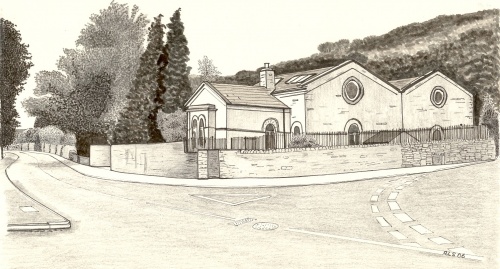
From The Knoll to Ferniehurst
Now return to Southdown Road and make your way along it. The green space over the wall to your right, which was the site of several rows of terraced houses, now affords a lovely view. The large rather utilitarian brick building on the other side of the green area – the Barracks, built in 1939 for the army – is now a recreation centre, left of which is a small cricket pitch. Beyond the Barracks
Just before the road reaches the junction with Cliffe Lane look again to your right; this vacant building plot (now much overgrown) was the site of Greencliffe School, which closed when Glenaire School was built at the bottom of Thompson Lane. The building was used for various purposes before it was finally demolished.
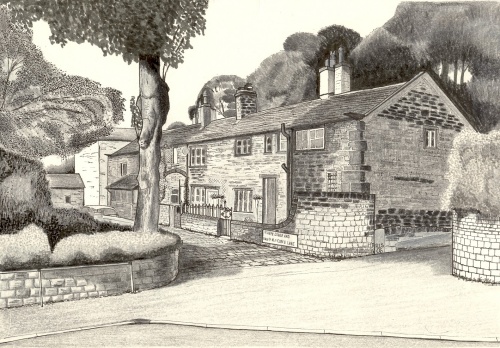
When you reach Cliffe Lane turn left and walk uphill; follow the road as it bends to the right and becomes Cliffe Terrace. Cliffe Lane is now no more than a trackway which leads uphill on your left (on the bend), but this used to be the original route up to Baildon from Shipley.
As you walk up Cliffe Terrace notice (on your right) the backs of some large stone houses which look over the valley. The first is Royd Mount, erected by Jonathan Walker who was a bookseller, etc., in Shipley. Above that is Oxenhope House, put up by Mr J W Parker who came from Oxenhope. And after several new houses is Spring Field House, built by Mr Samuel Lupton and later occupied by Mr John Robson, the gas and oil engine maker of Shipley.
You eventually come to the top end of Cliffe Terrace: it becomes Baildon Wood Court at the junction with Rockcliffe Avenue which runs down very steeply to your right. This is a splendid viewpoint across to Idle Hill (with the radio mast) and Wrose Brow to the right, with the industrial estates in the valley bottom. With sharp eyes (or binoculars) you can make out the red brick chimney with ‘John Smith Jams’; and a Victorian building now used by Saltaire Brewery (their sign is on the end of the building) which used to be where electricity was generated for Shipley and Saltaire trams. When you have drunk your fill of the view, or caught your breath, continue along Baildon Wood Court for a few yards, but where it levels off and swings slightly to the right you keep left uphill on the unnamed (and unpaved) track straight in front of you. You have now come to the area of Ferniehurst – and it is to the site of the former mansion (now modern housing) that Baildon Wood Court leads – but we shall approach the site from another direction.
Ferniehurst and the Dell
As you climb the track, the building up above you on your left is Ferniehurst Farm which was probably built in the 1860s as the home farm for Edward Salt’s house which was called Ferniehurst. Pass this farm and you will eventually come to a track branching off to your left with playing fields and open ground. The houses at this side of the track were built when there was a hackney carriage stud farm on the land in front of them; the stud farm was eventually replaced by Ferniehurst Primary/First School which has in turn been demolished. You can still see the bare foundations.
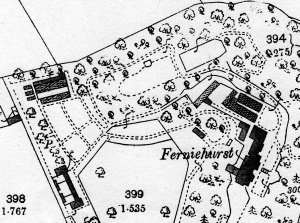
On the right hand side of the main track (the one you are on) is the site of Ferniehurst’s laundry; keep walking along the main track (past a football field on your left) until it turns sharply to your left, and you can see in front of you the cliffs of Baildon Bank. This area was extensively quarried for the good quality Rough Rock and Rough Rock Flags, which are part of the Millstone Grit series. The houses of Baildon Green would have been built from stone extracted there. Other uses for the stone were flagstones, kerbstones and lintels. The rights to extraction of stone was owned by the Lord of the Manor until the common lands were sold to Bradford Corporation in 1899.

This is also a popular area for rock climbing. If later you go to have a closer look, you may see the numbered climbs, which have names such as Pearly Gates, Paddy's Route and Twin Cracks. It was on the Bank that Ian Clough learnt to rock climb, after whom the Ian Clough was named (see The Baildon Village Walk). These crags are dangerous and climbing should not be attempted without expert assistance.
Instead of turning left here, where you can see Baildon Bank cliffs, you can turn right along a path and walk down into the Dell from where you can see the site of the Ferniehurst mansion. Ferniehurst was built by Edward Salt in the early 1860s. Edward Salt married his first wife Mary Jane Susan Elgood on July 10 1861; and it therefore seems likely that the house was built for her. The land belonged to Titus Salt who had wanted to build a house on the Knoll site but had changed his mind and sold it to Charles Stead. There are no known pictures of the house, nor building plans. However, the 1893 Ordnance Survey map of the area shows the basic plan of the house and of the extensive glasshouses and other buildings. Edward Salt had one of the foremost collections of orchids in the country, and the Odontoglossum House at Ferniehurst was considered a model of perfection. He lived at Ferniehurst until 1893 when, as a result of the restructuring of the family firm (and his own bankruptcy), he left the area.
His collection of orchids had been sold in 1892 and both the house and estate had been mortgaged to the Bradford Bank, who now foreclosed on the mortgage and the estate was offered for sale in 1892. The house was described as having 12 bedrooms, a tower, and a billiard room with a separate staircase. There were also outbuildings including a carriage house for six carriages, a separate laundry, a gardener’s bothy, three vineries and a mushroom house. The estate failed to reach the asking price and was withdrawn from sale.
It was eventually bought by George Camille Waud, a textile manufacturer, whose family owned Britannia Mills in Bradford (near the Interchange). His great interests were growing roses and breeding hackneys – a breed of horse, popular at that time as a harness horse, for which he built the stud at Ferniehurst mentioned earlier. In the 1920s he started selling off land from the estate. Temple Rhydding Drive, etc., were built on Ferniehurst land. In the early 1930s the house was offered to Baildon Council who declined to take it. The house and grounds were then sold to a quarrying company and the house was demolished. It is said that stone from the house was used to build houses in Rockcliffe Avenue. Baildon Council eventually acquired the grounds (in the 1940s) and laid them out as a recreation ground complete with a playground. (The Waud name survives in ‘Waud Gates’ which branches off Rockcliffe Avenue.)
At the the top of the Dell, on your right just before you pass through the gates, there is a large open playing field with a ‘Trim Trail’, with wooden outdoor fitness equipment, installed here in 2013 by Baildon Town Council, to promote healthy living. If you have lots of energy, you might care to try it out.
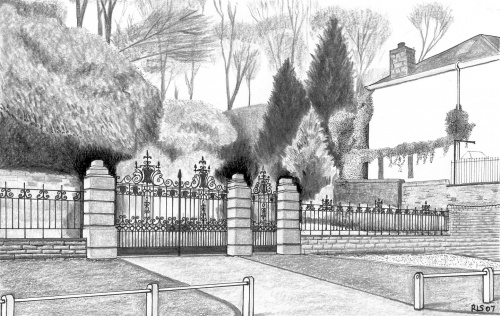
To go into the Dell, turn right and follow the path through the gates and past an information board until you come to the edge of the steep little combe; carefully follow the path downhill until you come to a flat grassy area. The Dell was originally the site of the gardens surrounding Ferniehurst; the crumbling walls on your right are all that remains of the house and gardens. The house was on top of the hill on your right hand side, where modern houses now stand (Baildon Wood Court). When it was built it had a magnificent view over the Aire valley.
In 2013 the Friends of Ferniehurst Dell secured a grant from the Armed Forces Community Covenant Committee for a considerable amount of work to be carried out in the Dell, to include both the improvement of the path and the creation of the Yorkshire Armed Forces Sculpture Trail, which was opened on 28th June 2014 (Armed Forces Day). There are 12 sculptures in different media, designed around the theme of issues affecting the armed force. The first sculpture at the top of the Dell is a wooden carving of a 1940s soldier by Simon Kent; the distinctive spherical sculpture by the gates at the bottom of the Dell was created by Craig Dyson in steel and copper and is called A Mind’s Eye. There is also a seated area, the community campfire, which was created by the Friends of Ferniehurst Dell as a functional sculpture, named ‘Camaraderie’, due to be completed in Spring 2015.
If you follow the path downhill you come to a set of ornate gates, where there is a handy leaflet dispenser, and a second information board, providing more detailed information. These gates were formerly the back gates for Baildon Town Hall on Rushcroft Terrace. Through the gates you come to Baildon Road, at the foot of which lies Otley Road, originally a turnpike road. Before the Turnpike road was built in about 1825, one Benjamin Thompson, who lived at Parkgate, the big house with grounds off Park Road in Guiseley, used to travel every day to Bradford through Esholt, Baildon and Shipley, often in the dark. At Baildon Woodbottom just below Ferniehurst, he once had a narrow escape from a footpad (a highwayman on foot). The wood was notorious for footpads and Benjamin carried a loaded pistol. (FromWilliam Cudworth's Round about Bradford 1876.)
At this point, if you’ve already had enough for today (and you don’t have to go back for your car), you can go through the gates and head either uphill to Baildon or downhill towards Shipley, on foot or by bus. (So far you’ve walked about 1¾ miles, or 2 km.) However, to continue this walk, retrace your steps through the Dell back uphill to the main track and follow it as it runs alongside the football pitch on your left. As you follow the track notice the sports facilities on your right: a bowling green and tennis courts.

When the track reaches Cliffe Lane West, you have a choice of ways back to the Cricketers pub and the second half of the walk. To walk through the council houses built on the Knoll estates, turn left and walk along until you come to a shop. Turn right by the shop into The Crescent, and then left into Denby Drive. Follow this road round until it turns to the right and brings you back past the Knoll flats and bungalows into Bertram Drive. Continue down to the end of this road and turn left down Green Road and back to the Cricketers.

However, alternatively, you could turn right into Cliffe Lane West when you come out of the playing fields, and when you come to the end of the houses turn left and walk through the open common land of Baildon Green. The path, which can be muddy at times, brings you out at the junction of Betram Drive and Green Road. Head downhill along Green Road to return to the Cricketers. (The total distance walked so far is about 2¼ miles or 3.5 km: a bit less if you walk across the Green.)
The Hamlet of Baildon Green
To catch your breath, take time to look at the notice board by the bus stop near the Cricketers pub. It provides information about Baildon Green and the surrounding area, some of which you have seen, and some of which you are about to enjoy. Then cross the road to the hamlet of Baildon Green. How far you will walk on this loop is rather up to you: the minimum will be just under ¾ mile or about 1 km if you go all the way down to Midgeley Farm and back, and more if you do much wandering.
It is thought that the hamlet is essentially late medieval, being part of the spread out farming community of Baildon, and grew first as a cluster of cottages. The buildings we see today are mainly mid to late nineteenth century, with some twentieth century alterations. There is a possible reference to this area in the mention of ‘a Grene House in Baildon’, recorded in 1546. The textile industry developed in the area leading to growth in wealth and population. What is certain is that in 1678 as recorded on a gravestone in St John’s Churchyard, Robert Leach of Bayldon Grene, clothier, died in his eightieth year. To have a well decorated grave slab at that time indicates considerable wealth.
One of the attractions of Baildon Green is that it still shows signs of how the hamlet has developed, with houses and paths at angles, suggesting that an attempt was made to keep the houses from encroaching onto the adjacent common lands. In addition local stone has been used for the houses and roofs, and local builders used vernacular styles. This contrasts strangely with nearby Saltaire (less than a mile away) where the streets were carefully planned and there was no organic growth. The buildings we see today are generally mid to late nineteenth century, with some twentieth century alterations and one ‘new build’.
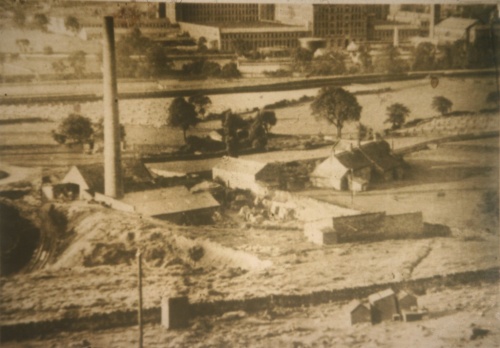
Baildon Green is the newest of Bradford’s Conservation Areas. It does not contain any listed buildings but the Church on the Green and The Cricketer’s Arms, together with several private residences are designated ‘key unlisted buildings’. Midgeley Farm, a little further down the hill in Thompson Lane which we shall see later, is a Grade II listed building but lies just outside of the actual Conservation Area.
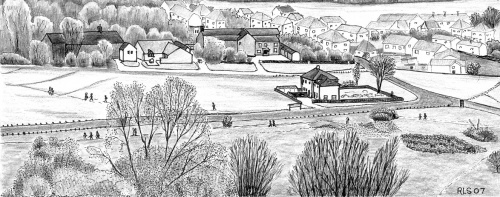
This part of the walk starts on the green where goats graze (opposite the Cricketers), the water supply is from one of two springs in the hamlet, Crutch Well, the other being Sheep Dyke.
Just beyond the goats is The Church on the Green, which was created from three cottages in 1858 at a cost of £15. It was given to the people of Baildon Green ‘to be used as a place of religious instruction for the youth of both sexes of parents residing in Baildon Green, for ever’. It was run by trustees who were required to live within a mile of it. The minister was unpaid, the first two being a chair maker and a foreman engineer. At one time over 70 scholars attended the Sunday school.
One big feature of life on the Green were the open air services or ‘stand ups’ held every June until the 1930s. One, held in 1880 to celebrate the century of the Sunday School movement, was attended by just over 1600 people. These were: Anglican 456, Charlestown Wesleyan 241, Baildon Primitive Methodists 220, Baildon Wesleyan 208, Moravians 172, Baildon Green Wesleyan and Christian Brethren 132, Charlestown Baptists 92, and Moorside Primitive Methodists 81.
The building itself is attractively designed in an Italianate Style. In 1988 the Telegraph & Argus reported that the 69 year old minister, Florence Greenhalgh, often preached to two people, the whole congregation being five. They were the last of the Independent Methodists. It closed for a while but has now fortunately found new life as The Church On The Green.
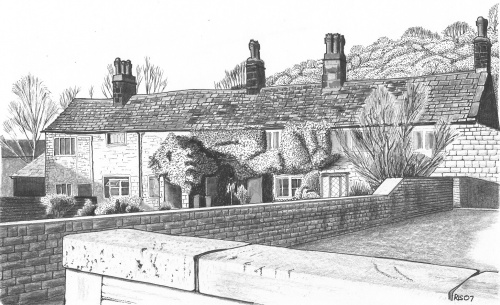
The mill behind the church is Baildon Green Mill, or Clough Mill. It was probably built around 1840 by James Clough. In 1868 it was shared by Cyrus Brook and Co, worsted manufacturer who also had a mill in Halifax, and Messrs Brearley who were steam engine manufacturers.
It is notable that unlike most of Baildon centre and the moorland hamlets, little demolition occurred in the 1960s. However the area where the garages are had 11 cottages called Greenside which were demolished – visible between the two parts of Knoll View (between 6 and 7), and at the top of Bankside Terrace, both of which we see later.
Baildon Green was at one time famous for its Gypsy gatherings. Held in June, up to 5,000 people were said to have attended in 1881, but the tradition did not last into the twentieth century. To raise money for the Baildon Hospital fund it was revived in 1929 and included a mixture of true Romanies and Baildon people dressed as Gypsies. They were undoubtedly lively occasions, but were not restarted after the Second World War. The stones around the Green were placed there c.1979 to prevent encampments. Immediately opposite the Cricketers, downhill from the church and mill, is Knoll View, built in the first half of the nineteenth century, with number 4 added later. Part of it was The Smiling Mule public house, doubtless named after the ‘mule’ spinning machine. The licence was transferred to the newly built Cricketer’s Arms in 1899.
The common land in Baildon Green was once used by Baildon Cricket Club – originally Baildon Green Cricket and Skating Club, founded in 1850. In 1893 they joined the Airedale and Wharfedale League and in 1910 entered the Bradford League. In 1913 they had to apply for re-election, part of their case being that a new ground was planned. In 1914 they moved to Jenny Lane and dropped the skating from their title, but not dropping the Green from the title until 1950, their centenary year. When they moved they took with them their old wooden pavilion, which they continued to use until Sir Leonard Hutton opened a new one in 1955.
Make your way downhill, parallel to Green Road. Note at Bankside Terrace the Victorian (‘VR’) post box in the wall, and above it, faint but still legible, the painted sign ‘Teas’, which were sold here well within living memory. Continue down to the bottom corner of the hamlet by the leaning willow tree – Lower Green. Number 2 Lower Green, the one nearest the road, was built in the late C17th as a farm and barn. It is possible that the barn became a malt kiln, known to be in the village, to be later converted into a cottage and finally both made into one dwelling in the 1990s. Walking up to the top corner of the houses, you come to number 16 Lower Green. This is a significant building, part of which was purchased in 1845 for use as a Methodist Chapel. By 1885 regular services had ceased, but it was occasionally used until it was sold sometime in the 1920s.
From the track above the houses you can see signs of a partially blocked archway, which suggests use as a barn, and a blocked-up taking-in door with a window.
Back down on Green Road, or on the track adjacent to it, walk downhill towards Thompson Lane. On the uneven land to the right there was a brick works, where ganister from Baildon Moor was mixed with local clays to produce fire bricks, used in local mills and houses. It was operated by Yorkshire Ganister Company and the chimney was demolished in 1908. The photograph of the brickworks, included a few pages earlier, shows it in a very rural setting before any of the modern houses of the area were built. Only the much older Midgeley Farm is nearby (see below), with Salts Mill visible in the background. The photograph must have been taken at harvest time, with stooks (group of corn sheaves, usually about 12, stood up together to dry) in the fields.
Where Green Road swings left and becomes Green Lane, opposite the junction with Thompson Lane, there are two houses built on common land. Houses are not normally allowed on common land, but this was the site of St Mary’s Mission Church built in 1872. It was closed in 1924, being used also as a school up to the time of its closure, and the land was then sold and the house building permitted.
Now walk into Thompson Lane, just round the first corner. There on the right you will find Midgeley Farm, itself an interesting building (you can see the back of it from Thompson Green). Here, in about 1800, a single cell 2-storey loom shop was added. This marks the move away from a truly domestic textile industry, where processing was done in living accommodation, to a separate processing-only system. Originally there was no internal connection with the house, and windows provided a well-lit area for weaving. The taking-in door is typical of those spread about Baildon. The first free-standing loom shops in the area were built at Addingham in 1797, which was the next stage of development.
A more agricultural snippet of history relating to Midgely Farm is related by John La Page in his book on Baildon. A Mr Steel who farmed here was making his way up Cliffe Lane (which we saw earlier) from Shipley one night with £200, the price of a large number of lambs he had sold. Passing through Knoll Wood he was set upon, and narrowly avoided being robbed: he managed to outwit the thieves by his superior knowledge of the undergrowth near the path.
That completes the walk, and we wish you a safe journey home! To return to your starting point, retrace your steps up Green Road to the Cricketers, or walk back to your car. Or you can catch a bus (uphill to Baildon; downhill to Shipley). However, if you came by train to Saltaire station, continue down Thompson Lane and across Roberts Park to the river and canal, and make your way up Victoria Road to the station. It’s only about ½ mile (0.8 km) from here, but about 1½ miles (2.3 km) back to Baildon station by the way you came.
Note about distances:
Distances in this walk are offered only as a guide. They are inevitably approximate, partly because they were measured from a map, but also because you’re very likely to wander about a bit looking at things as you go. Indeed, we hope you will, but we can’t predict how far. So look upon the distances given as a sort of minimum in each case.